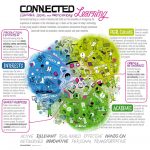
Time To Transform Public Schools: Part 3 – Don’t Drink the Milk
Welcome to Time To Transform Public School – Part 3! Take a minute to read Part 2 if you haven’t already, then come right back. This edition is primarily for public school principals and vice principals.
When my colleagues at TAF and I were planning TAF Academy we read every bit of research we could find, we visited schools, we met with a variety of educators and we drew upon our own experience running our after school programs to create the vision for the school. This was in 2004 right about when the education reform movement was heating up. At that time the Gates Foundation was pushing this notion of the new 3 Rs (Rigor, Relevance and Relationships) as the direction in which public education needed to move. That framework made sense to us because without giving it a name, we were already doing it in our after school programs and we knew it worked. Although the Gates Foundation work at that time was focused solely on high schools, we knew it could work for the whole K-12 system.
Over the next few years the 3Rs were all the rage. Presentations, professional development, new school structures, etc. were created and books were written by the new found “experts” on the 3Rs. Then realizing how hard it is to build relationships in comprehensive high schools where teachers have 150-200 students per year, the focus became rigor and relevance. Before this whole framework could really take hold, folks lost patience because test scores weren’t going up, the achievement gap was widening instead of narrowing and educators weren’t transitioning to this new model of education fast enough for the business minded people behind the education reform movement.
Next thing you know there was a flurry of education reform activity including more assessments, high stakes tests, changes in standards, evaluating teachers using test scores, bringing in Teach for America, increasing the number of charter schools, blended learning, online learning, etc.
You are probably wondering why I took you on this little bird walk, aren’t you? I wanted you to understand that TAF Academy is built on the foundation of the 3Rs because we believed it was the best way to educate children and prepare them to build their own futures. We were intentional and focused about it, we gave it the time it needed to work and we continue to build upon it and make it better. Our school culture depends on it. We put a line in the sand and stuck with the core idea while making necessary small adjustments to fit the school community.
We had the luxury of creating a school from the ground up, so it was a bit easier than transforming a school, but the process is not much different. This can be done in an existing school, albeit with extra challenges, when everyone is on the same page and willing to put the effort toward it.
Creating a School Culture–Intentionally
Most public schools that do not bear a special label (magnet, language immersion, STEM, Arts, etc.) do not have an established school culture that the district can hold up. When you enter these schools you get no feeling of what the school is about other than schooling. It starts with creating a vision (which we covered in Part 2) for your school and the type of culture you want it to have.
Understand that every school has a culture whether it was intentional or not. You want it to be intentional so you can create an environment that will invoke the highest levels of teaching and learning. The culture of a school is really how you want everyone to relate to each other, the types of outcomes you want for students, how you teach, how families are connected, the way you want staff to interact with other adults, who all plays a role and how, your norms, etc. When people walk into your school and spend a little time, they should be able to feel your culture as they move throughout the building and interact with folks.
An established culture transcends the changes in leadership and staff. It provides a level of consistency that is missing and much needed.
But There Doesn’t Seem to be Time!
A few months ago a colleague and I met with a principal who is interested in having TAF partner to transform her school into a STEM school. I asked her what type of culture does she want her school to have. She was very honest and said she hadn’t thought about it and doesn’t really have time to with all the day to day things she has to handle. Curious to see if she was an outlier, I then approached a few other school leaders with the same question just to see what kind of response I’d get. It became very clear to me that school leaders don’t often have time to actually think about what they want their school culture to be and they are basically surviving instead of thriving. Mandates come down from the feds, the state and the district and they don’t often mesh with each other or make the learning environment better for their school. And as soon as they get a handle on one thing, something new comes along. No wonder there’s no time to really think about the possibilities!
An Example
There are several ways to go about defining your culture. Here is the TAF Academy culture as defined by our staff, the principal, the teachers and the parents:
TAF Academy is a STEM school rooted in a culture of equity, authentic learning, academic achievement and college readiness. Learning is designed for and often by the students, teachers collaborate as part of their daily practice and learn alongside their students, parents are welcome in the classrooms at any time, and professionals in other fields participate in teaching and learning. There is a bond of caring at the school between all the groups—Teachers, students, and support staff—where people look out for each other and students support each other to do their very best.
First Clear Your Mind and Don’t Drink the Milk
When you go about the task of creating a culture, completely clear your mind of all the mandates that have been foisted upon you. Pretend you are starting from scratch. Put yourself and your leadership team in a place that evokes imagination. Don’t even think about any of the day to day issues and activities. The moment someone starts saying the words like “but” or “can’t” or “mandates”, stop them in mid sentence and get them back on the “imagination track”.
Here’s a little fun way to think of it. Depending on what age you are, you may remember the Little Rascals episode where the kids were at a couple’s home (an orphanage really) and are being fed mush . The kids whispered in each others’ ears one at a time like this: Kid 1: Don’t drink the milk, Kid 2: Why?, Kid 1: It’s spoiled. Take a quick look. The “milk” in our case is all the policies, procedures curricular decisions, etc. that have been piled on our schools with very little stewardship or regard for how it impacts the school culture. And just like the mush our Little Rascals friends were trying to eat, everything becomes one large conglomerated mess.
When you’re defining your culture, the “milk” has no role. Just remember don’t drink the milk!
Once you have the first draft of your culture defined gather staff, parents and students to talk about it and solicit feedback. There are many protocols you can use to do this that will enable you to get the best, most complete feedback possible. Hone the draft into the final culture definition.
How to Handle Spoiled Milk
Now you can start thinking about how to deal with the “milk”. It’s spoiled right now in its current form and your job is to figure out how to get the best out of the spoiled milk and make it work with the new culture you have defined. You have to create policies and procedures that fit your culture, but some may not jive with the “milk” you have been given. For instance, if your culture is one of mutual respect where problems are solved directly with all involved, then the district’s suspension policy may be in direct conflict with how you would approach the issue. Another example may be a shift to requiring teachers to collaborate as part of their regular duties. This may collide with the bargaining agreement and how teachers use their time.
Defining and implementing a school culture is not for the faint of heart. For one, you have to be intentional and not be tempted to go back to what you know–particularly if what you know isn’t working, but is just easy. You have to normalize it as much as possible without making it a management task. You have to have faith in your team and your process which means you must prioritize and not sweat the nonessential stuff. You have to made decisions about how you use your time in your learning environment versus what the district expects of you (for instance you may have to skip some district meetings that don’t positively impact your school in favor of helping teachers lead PD sessions).
Don’t go it alone. It is best to involve an outside entity to observe your current culture and do a quarterly review of how you’re progressing in your new culture.
An Invitation to Participate in My Informal Research
Wouldn’t you like to know what your child’s school culture is and what is expected of them? So would I. Ask your principal this simple question: “How would you define the culture of our school?”. If you have time and the inclination to do so, please send me an email with the answer. I don’t need to know the name of the school, just whether it’s elementary, middle, high, K-8, K-12 or 6-12. You can email me at: trishmi@techaccess.org. Please use the subject “My School’s Culture”.
Thanks for taking the time to read this! I’m interested in your comments, so please do.





Dear Trish and TAF staff,
I have been a long time follower of your program, and this subject and how you guys have transformed the STEM approach is a subject it would like to further investigate and understand better.
As you will be able to see from our website, I am trying to tackle an area where school counselors, coaches, parents and administrators are falling short. We have done much research on the new initiatives coming from the NCAA in college eligibility. Presently the GPA requirement is 2.0, which will change to 2.3. We are for higher standards, but, when you look at the schools I’m looking to help, they have a historical record of low scores and achievement. Which is another subject.
The real student athlete issue coming in 2016 is the need to have 10 core classes done by the end of your junior year. If you do not have that done, as the NCAA says, “take a knee”. This impact will be significant for inner city kids. If they do not have good direction and are on a path to accomplishing this, there will be no recourse. I’m attaching an article I wrote about this, which was published in the Seattle Times, and Washington State Coaches Association.
http://blogs.seattletimes.com/take2/2014/05/16/ncaa-eligibility-changes-a-looming-crises-for-prep-athletes/
I would love to visit TAF and learn more about the strategies that you have used to get into the school districts. One of them is that we are working hard of making our company culture be a part of our success. And why your article resonates with us.
We would love any time we could talk with you by any means necessary!
Thanks,
Scott Laigo
President NWASD
The CORE to your FUTURE!